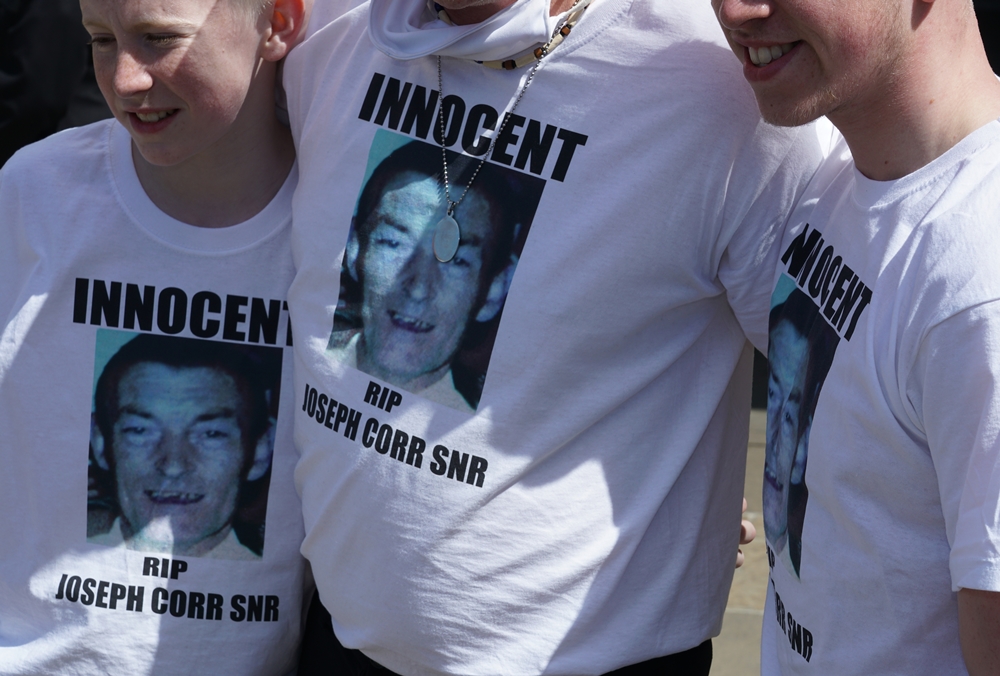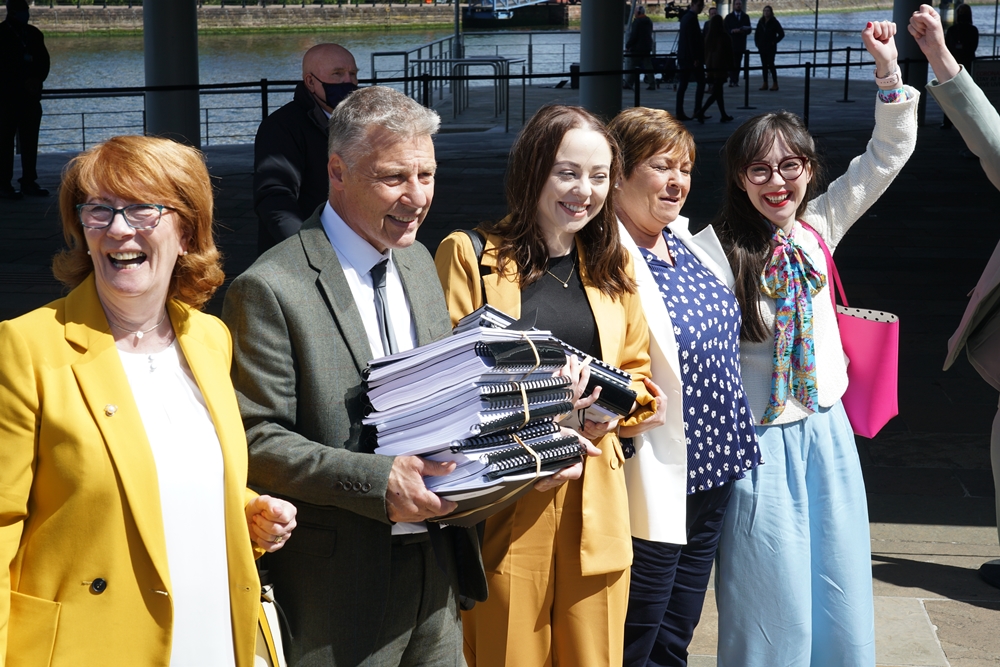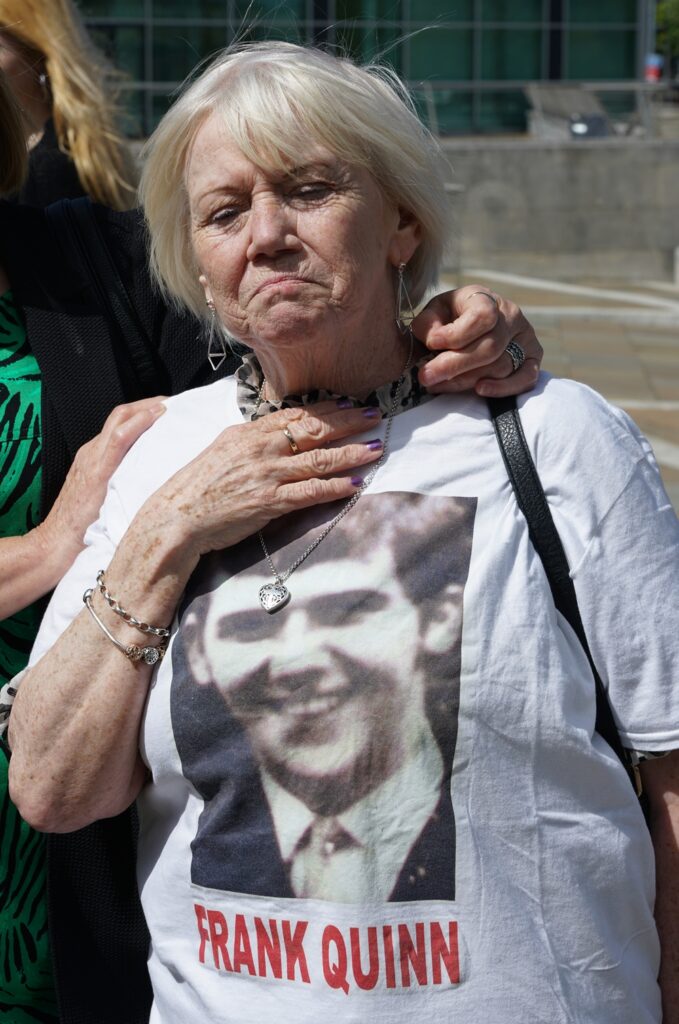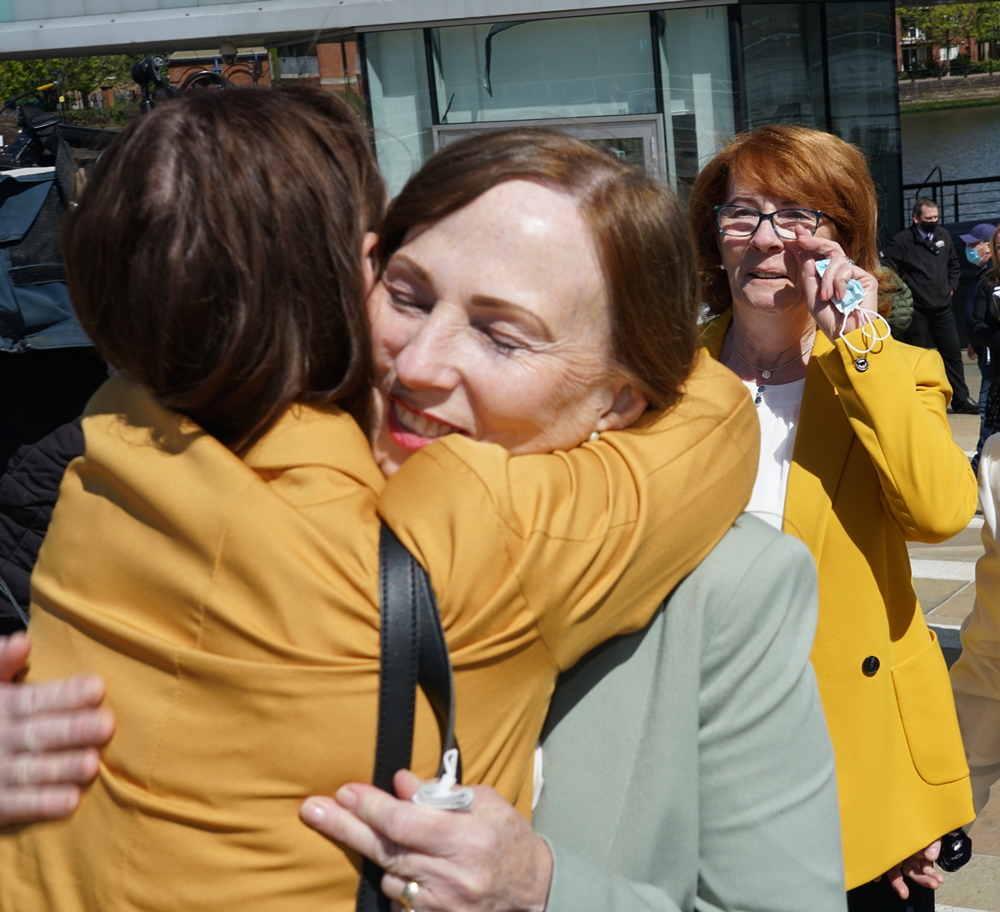The publication of the Ballymurphy coroner’s report earlier this week has thrust the spotlight onto Troubles-related inquests once again.
The Times reported on Wednesday 12 May that “it is not clear how ministers plan to proceed with inquests into deaths during the Troubles, of which there are about 50 outstanding….” The Northern Ireland Office would not confirm or deny this report, which casts doubt on the current schedule of inquests. In response to questions, a government spokesman reiterated that, “The Government is fully committed to introducing legislation to address the legacy of the Troubles in Northern Ireland and will confirm further details as soon as possible.” However, any suggestion that legacy inquests might be further delayed or halted is likely to cause surprise if not dismay.
No-one who has known the story of the Ballymurphy Massacre, followed the inquest, visited the narrow streets of the Catholic enclave or talked to families and supporters of the ten victims will be surprised by Tuesday’s verdicts from Justice Siobhan Keegan. In that sense, the judgements were something of an anti-climax. Pictures of the jubilant families carrying or wearing photographs of their loved ones made the front page of almost all the next day’s newspapers in both the UK and Ireland.
All ten victims were declared entirely innocent, the violence of the killings disproportionate and unjustified and in violation of ECHR Article 2 on the right to life; and the investigations at the time by the Royal Military Police were found to be entirely inadequate. In nine cases, the coroner determined the cause of death to have been shots fired by the British Army; in the last case, that of Joe McKerr, a married joiner and the father of eight children, she could not say definitively who killed him.

Vindication
The families have lived for almost fifty years with the rumour and accusations that their loved ones were carrying weapons or active in the IRA, and they have now been completely vindicated. Now also, Prime Minister Boris Johnson has apologised unreservedly for the deaths, although he left it to Secretary of State Brandon Lewis to deliver an apology in person to the House of Commons on Thursday. That may not, however, dissuade families from wanting to pursue criminal prosecutions of soldiers in the wake of the inquest.
Those prosecutions are unlikely to happen. In an unfortunate and ironic coincidence, the Conservative government gave notice in the Queen’s Speech, delivered at exactly the same time as the coroner’s judgement, of their plan for a statute of limitation to protect all military veterans and paramilitaries from prosecution (except in cases of war crimes and torture) for acts prior to the Good Friday Agreement.
In an oxymoronic statement released after the Queen’s Speech, Brandon Lewis, stated that “we will address the legacy of the Troubles in a way that helps society in Northern Ireland to look forwards rather than back, while delivering on our manifesto commitment to veterans who served in Northern Ireland.”
In a second statement released by the Northern Ireland Office, the Secretary of State said: “It is clear that the current system for dealing with the legacy of the Troubles is not working for anyone.” This is a strange statement for there is not, and has never been, any coherent system for dealing with the legacy of the Troubles. The agreed proposals in the 2014 Stormont House Agreement were never implemented. Arguably the most effective attempt was the 2009 Report of the Consultative Group on the Past, chaired by Robin Eames and Denis Bradley. Its conclusions were famously blown out of the water by unionists who forcefully rejected its recommendation that the nearest relative of anyone who died as a result of the conflict should receive a one-off payment of £12,000.

The peace process in Northern Ireland is incomplete, stuck, frozen. It is hampered by a dialogue of the deaf among the protagonists and interested parties in the conflict: republicans, unionists, British army and government, and the Irish government. (A current podcast series Gunplot from RTE, about the 1970 Arms Crisis, offers a riveting account of the keystone cops interventions by the Irish government in the early years of the conflict.)
All protagonists in the Troubles continue to stick rigidly to their own scripts. As Denis Bradley, interviewed again for this article, points out, there is no-one dealing with the Northern Irish legacy question “in its totality.” Everyone – unionists, republicans, the politicians in the Northern Ireland and UK governments, even the victims, are “self-centred,” i.e. partisan. I have outlined in a previous article on Northern Slant how the government’s policy on the legacy has evolved over the last year and in particular since Julian Smith MP, said by many to have been the best Secretary of State perhaps ever, was replaced by Brandon Lewis MP.
Establishing the truth
Against this backdrop, recognition is due to the remarkable work of the Ballymurphy inquest coroner, Dame Justice Siobhan Keegan. Formerly a barrister who specialised in family law, she was in 2015 one of the two first women judges appointed to the High Court of Northern Ireland. Reading through the over 700 pages of the inquest reports into the five distinct incidents of the Ballymurphy killings, I am struck by the diligence and compassion with which she has heard, valued and weighed the contribution of each of the over 100 military, civil and eye witnesses who contributed during over 100 days of testimony, despite the “frailties of memory and historical evidence” – making it the longest ever inquest on the island of Ireland.
In coming to her measured and forthright conclusions, she has needed to make a number of very finely balanced decisions. It is no surprise that it has taken over a year to produce the final report. Rather than “picking through the evidence for consistencies and inconsistencies,” she chose to take “an overall, holistic view in the search for answers.” In so doing, the Ballymurphy process has demonstrated the validity of the inquest as a mechanism for unravelling these complex and incendiary cases.
The report outlines the lengths to which Justice Keegan went to track down military witnesses and the multiple ways in which those attempts were deliberately, or through inefficiencies and ineptitudes of one kind or another, undermined. She was aware that some veterans were encouraged not to cooperate with the inquest and to put the coroner’s letters “in the bin.” At one point, the emergence of an “unpaginated, ill defined bulk of 4773 records of soldiers who had served in Northern Ireland offered in late August 2019” (nine months after its start) “had the potential to totally unravel the inquest,” to “throw it off track.” Nonetheless, several hundred further enquiries were sent to soldiers and the list of 60 core military witnesses expanded to 127.
Justice Keegan’s understanding also extends to the role of the military:
“I must also consider the management of this operation. Having done so, I find this was lacking in certain respects on the basis of the evidence I have heard. I wholeheartedly accept the perspective of military witnesses I heard from who said they felt frightened and under attack. Many of them were young men at the time who told me that they were simply obeying orders. On the basis of the evidence I have heard there does not appear to have been clear guidance given to young soldiers on the ground as to what they should do and there was a perception that everyone [in the area] was in the IRA or associated.“
The coroner concludes that there were some IRA operatives active during those days in Ballymurphy (although there appears to be no sign that any of them, despite the explicit aims of Operation Demetrius’s assault on Ballymurphy, were interned, killed or injured). Despite the allegations of the British Army, she sees little evidence of UVF activity in Ballymurphy at that time and none that it was responsible for any of the killings.
Justice Keegan’s ability to focus on what is truly important shines through on every page. It does not matter, she notes, what the white object the peacemaker priest Fr Hugh Mullan was carrying, whether it was a handkerchief or a t-towel, “he was waving a white object.” It was still light, he was dressed in black, as a priest, he was going to the field to help an injured person and he was shot twice in the back.

With regard to the deaths of Mrs Joan Connolly, mother of eight, and Mr Joseph Murphy, the coroner notes that there was a “basic inhumanity” in the way Mrs Connolly was left in the field and later transported to the hall, and a lack of “diligence and respect;” Mr Murphy was also handled insensitively and the family were badly treated. “Some personnel were triumphalist and abusive, including by means of physical abuse.”
According to the law in Northern Ireland, the coroner “must not express any opinion on questions of criminal and civil liability” and therefore cannot return a verdict of unlawful killing. Nonetheless Justice Keegan’s inquest reports “leave us in no doubt as to what really happened,” according to Bridget Dolan QC, commenting on the inquest report published in January 2021 into the death of Patrick McElhone.
Ms Dolan says: “Mrs Justice Keegan demonstrates how to tell the story of any death in a brief, concise, yet comprehensive narrative. The verdict is so well worked that one doesn’t need to set out much of the background for the reader to understand what went on.”
A new approach to legacy?
The Ballymurphy inquest completed, attention returns to the government’s plans for the overall policy on the legacy of the Troubles, and the role of coroners’ inquests within it.
The government has already signalled that it intends to announce a new approach to the legacy, likely to include a “Mandela style” truth and reconciliation process and a museum of the Troubles. The new approach would focus on information recovery and reconciliation.
As is often repeated, 1,186 of the conflict related 3,200 homicides in Northern Ireland from January 1969 to 10 April 1998 remain unresolved. Of these, 338 involve killings by security forces. Of the 94 deceased who are included in the fifty legacy inquest cases, 55% were killed by state forces.
Unionist politicians consistently blocked the release of funding for coroners’ inquests called for by the 2014 Stormont House Agreement. However, in March 2018, High Court Justice Sir Paul Girvan held that First Minister Arlene Foster’s decision not to permit a paper on legacy inquests to go to the Executive Committee was unlawful. He directed that additional funding for legacy inquests was to be provided. That funding was released by the Northern Ireland Department of Justice in February 2019 to deal with the outstanding legacy cases over a period of five years.
According to the Lord Chief Justice’s Office, Covid-19 has affected the schedule hearing of the legacy inquests. Of the 10 inquests that were due to be heard in Year One of the Lord Chief Justice’s plan, two are ongoing (Kathleen Thompson and Neil McConville), four have been listed for later this year and the other four are still being prepared for hearing. One inquest which was not initially in Year One (Patrick McElhone) was concluded in November 2020 and the findings delivered in January 2021.
Meanwhile, in December 2020 the UK Ministry of Justice in a report to the Joint Committee on Human Rights recalled that:
“Under article 46, the European Court of Human Rights indicated that the authorities had to take, as a matter of priority, all necessary and appropriate measures to ensure, in similar cases of killings by the security forces in Northern Ireland where inquests were pending, that the procedural requirements of Article 2 would be complied with expeditiously.“

It would therefore be surprising if the forthcoming government proposals on addressing the legacy were to change the plans for legacy inquests. Bradley is “absolutely delighted” for the Ballymurphy families and at the same time concerned that hopes will be raised for a judicial process which is unlikely to occur. He is also concerned that, in the absence of recourse to other judicial processes pressure will be placed on the inquest procedure as a means to achieve at least partial resolution of the cases which continue to bedevil the peace process in Northern Ireland.
Just this week the family of Joe McCann, an Official IRA member shot in the back as he was running away, called for an inquest into his death after the trial against two soldiers collapsed and they were acquitted due to inadmissible evidence.
Commenting on the suggested proposals for a truth and reconciliation process, Bradley notes that what is actually being proposed is an information gathering process. The design of any legacy mechanisms should, he says, be based on mature reflection not just the partisan views of the partisan conservative right wing. They need to be overseen by a legacy commission of people of international standing. Otherwise, he foresees a “quagmire” in the Irish peace process.
Against the backdrop of the Northern Ireland Brexit protocol and a tense situation with loyalists, the imminent election of a new leader of the DUP and its potential impact on the power-sharing Executive, and the looming 12th July celebrations, we await with interest, curiosity and not a little trepidation the Conservative government’s proposals for addressing the legacy of the Past.
